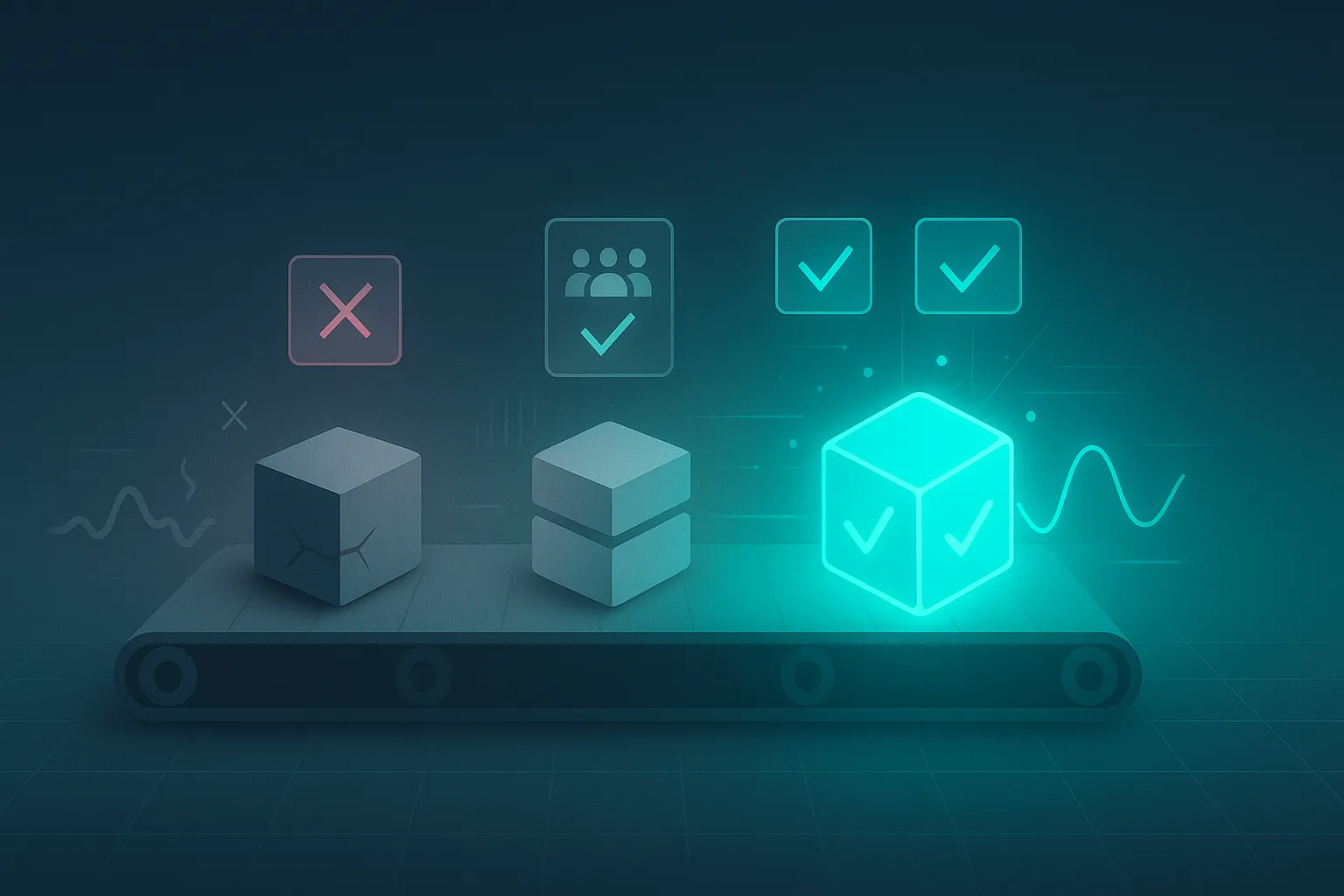Why Better Data is Your Secret Weapon in 2025
The world of ASR is obsessed with bigger models, faster GPUs, and more data. But here’s the truth bomb for 2025: Better data always beats bigger models.
Your ASR model’s performance isn’t determined by how complex your model is, but by the quality of the data it’s trained on. A model built on flawed, inconsistent, or narrow datasets will struggle, no matter how many parameters you throw at it. And we’re not talking about small differences here. Bad training data can increase Word Error Rates by up to 10%, while high-quality, diverse data can boost accuracy by 15-30%.
To put this into perspective, recent advancements in large-scale, diverse speech datasets in 2025 show that data diversity significantly impacts ASR performance. A comprehensive English speech dataset, comprising 25,000 hours of transcribed audio, was introduced early this year. This dataset is designed to include a wide range of accents, dialects, and environmental conditions, providing a more real-world training foundation for ASR systems. The result? Models trained on this data perform significantly better across a variety of accents and conditions than models using traditional datasets.
Let’s dive deeper into the five critical data insights that will elevate your ASR models to the next level.
Scale and Diversity Matter More Than Size

When you think of training data, your first instinct might be “bigger is better.” But what if we told you that size alone doesn’t guarantee success? In fact, too much homogeneous data can actually be detrimental.
For example, a Fortune 500 bank trained its ASR on 12,000 hours of call center data. On paper, it looked impressive, but 80% of that data came from a small group of middle-aged male agents. Their ASR model struggled to understand younger customers or those with different regional accents.
This points directly to our first insight: Data diversity is essential. A 5,000-hour dataset with balanced representation across demographics will outperform a 15,000-hour dataset that only covers one group. It’s not just about the quantity of data, but about its representative diversity.
This lesson is further validated by a study released in 2025, which introduced an innovative dataset of multilingual speech captured in real-world environments. The data was specifically curated to cover a broad spectrum of dialects, including regional variations from different corners of the world. This diverse dataset helped improve ASR model performance by ensuring that the system could handle various accents, backgrounds, and languages.
A dataset that’s diverse, across age, gender, accent, and language will outperform a massive, homogenous dataset every time.
Audio Quality is Your Hidden ASR Accelerator

Now that we’ve established the importance of dataset diversity, let’s talk about audio quality. This is where many teams slip up. It’s tempting to think that bigger models or more data will solve all your ASR problems, but the truth is: poor-quality audio will limit your model’s potential.
Your ASR system learns from patterns in the audio, not from language itself. So if the audio is poor, whether it’s distorted, clipped, or poorly recorded, the model will simply learn those imperfections. No amount of scaling or complex models will fix that.
Users don’t speak in pristine, controlled environments. They speak from their cars, in crowded cafes, or while cooking dinner. If your dataset only includes perfect, studio-quality recordings, your ASR system will crash when it faces the messiness of real life.
In 2025, a study reinforced the necessity of incorporating real-world audio quality into training datasets. A dataset released earlier this year, for instance, aimed to enhance ASR performance in noisy conditions by including both clean and noisy audio data. This mixed dataset allowed ASR systems to adapt to diverse environments, improving their accuracy under real-world conditions like background chatter or street noise.
Audio quality isn’t just about clean recordings; it’s about real-world noise. If you haven’t trained your system to handle everyday chaos, it won’t be ready for real-life interactions.
Transcription Integrity is the Key to Accuracy

Let’s go back to something that’s often overlooked: transcription integrity. Many teams feel satisfied with a transcription accuracy of 97%, but here’s the problem: the last 3% could contain critical errors that break the whole system.
A missed word or minor inconsistency might seem harmless, but imagine you’re working with medical or financial data. A small transcription error, like mistaking “$50” for “50 dollars” can cause major issues. What’s worse is when the transcription data is inconsistent, one annotator writes “$50,” while another writes “USD 50,” and a third writes “fifty dollars.” That’s not just a minor issue that creates chaos for your model.
Consistency is key here. The best teams like FutureBeeAI ensure that their annotations are precise, uniform, and accurate. They implement style guides, multi-pass reviews, and quality checks to avoid introducing inconsistencies that could derail the entire model.
High-performing ASR isn’t built on data that’s “close enough.” It’s built on data that’s consistently accurate across the board.
Why Demographics and Dialects Make or Break User Experience
Think you’ve covered all the major dialects? Think again. Dialects and speech variations can make or break an ASR system.
It’s easy to assume that a few accents or age groups are enough to cover your user base. But the reality is that the dialect variations and subtle speech differences between people are what often lead to ASR failures.
Think about it: younger speakers often talk faster, and non-native speakers may pause differently or stress syllables in a unique way. Even within a single language, accents can differ widely. The Hindi spoken in Delhi sounds different from the Hindi spoken in London, and the Spanish spoken in Mexico City differs from that of Madrid. If your data doesn’t account for these regional nuances, your ASR system will falter when faced with these variations.
To address this, a dataset released in June 2025 focused on German dialects to test how ASR models performed across regional accents in the Southeast of Germany. This dataset included not only standard speech but also local dialects and colloquialisms, further proving that demographic representation is key for accurate and inclusive speech recognition.
To create a truly inclusive ASR system, your dataset needs to represent the full spectrum of your users’ dialects, accents, and speech habits.
Training for Real-World Environments is Crucial

All the previous factors, like scale, quality, consistency, and representation, come together to shape a robust ASR system. But what about the real-world environments where users will actually interact with your system?
Here’s the problem: ASR models often perform flawlessly in controlled, quiet environments but struggle in the messy, noisy, real world. And guess what? The real world is full of background noise. Whether it’s a bustling café, the hum of a car engine, or the chatter of multiple people, your ASR system will face all kinds of environmental challenges.
In 2025, a benchmark study evaluated ASR performance using 205 hours of real-world audio data from diverse environments like offices, streets, and cars. This expanded dataset provides the most accurate assessment of how ASR systems behave in real-world settings. By training ASR systems on this varied data, models become much more robust and capable of handling the unpredictable nature of user interactions in real environments.
Don’t just collect data from quiet rooms. Your training data should reflect real-world conditions, cafes, cars, offices, and streets. This will help your model become more robust and adaptable to the unpredictable nature of real-world speech.
Train your model for the chaos of the real world. Only then will it perform when it’s needed most.
Turning These Insights Into Action
Now that you know the five key factors that will supercharge your ASR models, how do you put them into action?
- Start Small and Test Early: Begin with a pilot dataset (100–200 hours) and focus on diversity, quality, and accuracy. This gives you the chance to uncover issues early before scaling.
- Scale Thoughtfully: Once your pilot dataset proves successful, gradually increase your dataset size while maintaining balance and integrity.
- Automate, But Don’t Rely on It: Use automation for quality checks and error detection, but always have human oversight to ensure consistency and accuracy.
- Document Everything: Keep detailed metadata for each recording device type, speaker demographics, and environment.
- Iterate and Improve: Continuously collect feedback from real-world users to refine and improve your dataset.
Building a robust ASR system isn’t about collecting massive amounts of data; it’s about carefully crafting datasets that are diverse, high-quality, and tailored for real-world conditions.
Stress-Test Your Data Before It’s Too Late

It’s time to talk about stress-testing your data. Many teams validate their models but forget to stress-test their datasets before they even touch the GPU. This is a huge mistake.
Key steps for stress-testing:
- Simulate real-world conditions: Check your dataset to ensure it includes noisy, challenging environments, and edge cases.
- Consistency checks: Ensure that annotations and transcription styles stay consistent across all data points.
- Reality check: Does your data reflect the environments and speaker demographics your model will face?
- Validate your data before your model. Catch potential flaws early to prevent costly issues down the road.
Cutting Corners on Data Will Cost You More Later

It might seem like a good idea to cut costs on data collection and transcription, but it’s a trap. While cheap data can save you money upfront, it’ll cost you far more in the long run.
Important Point: Quality data is an investment, not an expense. Cutting corners will only cost you more in the end.
Conclusion
Data is the Foundation for ASR Success in 2025. The bottom line is clear: the strength of your ASR system will always be rooted in data quality. As we’ve explored, a high-performing ASR model requires diverse, high-quality data that represents the real-world environments your users will encounter.
If you’re ready to build an ASR system that’s future-proof, scalable, and reliable, start by focusing on your data strategy. At FutureBeeAI, we specialize in creating clean, diverse, and real-world-ready datasets that help you unlock the power of your ASR models. Explore our AI/ML data collection services and speech data collection to elevate your ASR systems to the next level. At FutureBeeAI, we specialize in creating clean, diverse, and real-world-ready datasets that help you unlock the power of your ASR models.











-data-collection/thumbnails/card-thumbnail/top-resources-to-gather-speech-data-for-speech-recognition-model-building.webp)
